A Slightly Obsessed Genre Special!
OVERVIEW
Back in 2013 I started a weekly, self-imposed discipline of movie write-ups on my Facebook page. My intent—besides meagerly attempting, admittedly, to self-justify over half a lifetime of obsessive movie-watching—was to find a format for writing about movies that is both entertaining and informative. Basically, I thought that if I could in any way pique a theoretical reader’s interest in classic movies or movie history, then I would consider the modest venture a rousing success.
Over this four week period, then, I’ll be rolling out the very first from these “series” on classic movies which I’ve here re-named “American Genres.” Identifying four distinct, uniquely homegrown categories of American filmmaking, I trace the chronology—in terms of convention and thematic content, mainly, but also in terms of their historical development—through eight “key” examples from each chosen genre.
While by no means an exhaustive survey or a rigorously-academic analysis, these are rather brief, hopefully engaging and accessible essays—written from the vantage of being a movie ‘enthusiast’ as opposed to a ‘writer’ or ‘critic’—on some of my personal favorite movies. Hope you enjoy!
INTRO: SCREWBALL!
Wild & Woolly Early Years: 1934 – 1940
For the first part of this series of write-ups, I shall attempt—with little success, perhaps—to slap a little sense into my favorite genre of Classic Hollywood filmmaking…
The Screwball Comedy.
So what’s a Screwball? Academically, the term refers to the sweep of romantic comedies made by major Hollywood studios between 1934 and 1941, emphasizing loony plots, fast pacing, and witty dialogue over mushy romantic posturing. Notable examples include It Happened One Night (1934), My Man Godfrey (1936), The Awful Truth (1937), Bringing Up Baby (1938), His Girl Friday (1940), The Philadelphia Story (1941), and The Lady Eve (1942). Actors and actresses most associated with the genre, many of whom starred in the films listed above, include Cary Grant, Carole Lombard, Jean Arthur, James Stewart, Rosalind Russell, Katharine Hepburn and William Powell.
As one of the above examples so elegantly put it, “the love impulse frequently expresses itself in terms of conflict.” Envisioning the vagaries of romance as a grand battle between the sexes—a knockdown-dragout that either ends in mayhem, attempted murder or, as last resort, marriage—screwball comedies achieved the near-miraculous by making sex entertaining. Mostly by ignoring it altogether—an elaborate waltz around Classic Hollywood’s most draconian notions of self-censorship and prudishness—in favor of bright farce, broad slapstick, and brilliant repartee crafted by some of the best wordsmiths of the silver screen.
So for anyone who looks askance at the whole idea of romance, or who thinks love is best taken as a tumblerful of orange juice & vodka (a SCREWdriver), or a hipflask brimming over with scotch & soda (a highBALL), then this is your genre, bub: mix all THAT together, friends, and you’ll be as slaphappy as any dizzy dame and her bewildered beau. Innuendo-laced, and spiked with mirthfully-suggestive metaphor, a well-mixed SCREWBALL begs the inevitable question: how can anyone take something so seriously which looks so darned ridiculous?
I. IT HAPPENED ONE NIGHT (1934, Columbia, dir. Frank Capra)
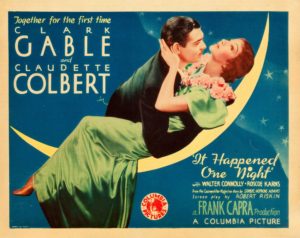 Kicking off this series of Classic Hollywood genre write-ups with a picture largely-credited with having kickstarted the whole darned genre, It Happened One Night was not only the first picture to win all five major Academy Awards (picture, director, actor, actress, and writer) but also singlehandedly bumped up a fly-by-night, struggling film studio (Columbia) from its Poverty Row origins to the major league ranks of MGM, Warner Bros., Paramount, et al.
Kicking off this series of Classic Hollywood genre write-ups with a picture largely-credited with having kickstarted the whole darned genre, It Happened One Night was not only the first picture to win all five major Academy Awards (picture, director, actor, actress, and writer) but also singlehandedly bumped up a fly-by-night, struggling film studio (Columbia) from its Poverty Row origins to the major league ranks of MGM, Warner Bros., Paramount, et al.
It was also the first film of the sound era to win household name recognition for a filmmaker, marking “Frank Capra” in the public’s mind as Hollywood’s very first “producer-director.” And oh yeah, Clark Gable’s performance—particularly, munching on a carrot after a night spent in a field—probably even served to inspire the beloved cartoon character of Bugs Bunny. So let’s take a brief look-see, shall we?
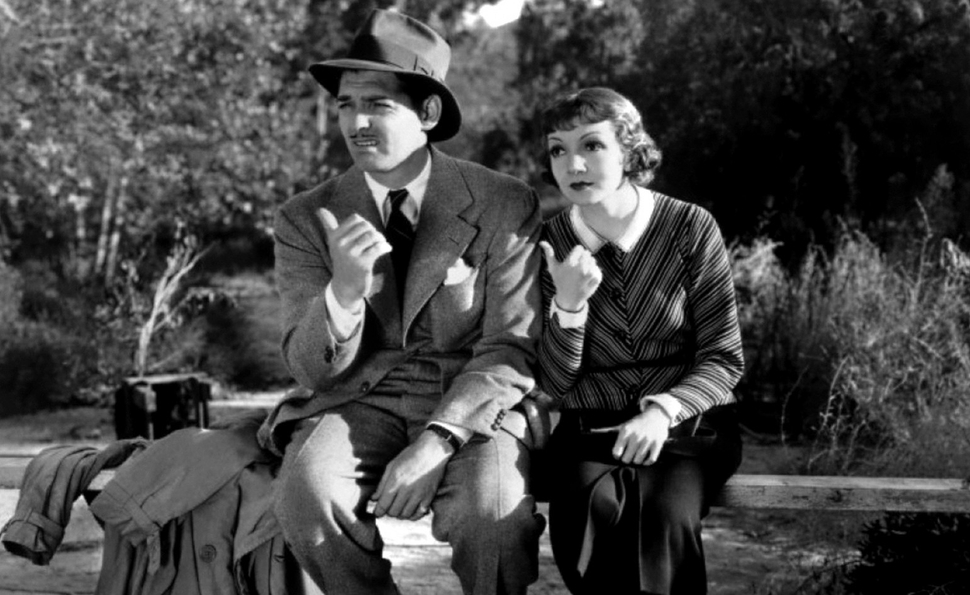
“Behold the Walls of Jericho!”
A stubborn heiress (Claudette Colbert) flees home to marry a wastrel ‘aviator’ calling himself “King” (and, surprisingly, a lotta people did back then; Jameson Thomas), pursued by the agents of her wealthy father (Walter Connolly), who objects to the proposed union with equal adamancy. On the long bus ride north to New York City, the spoiled-rotten rich girl meets up with ‘man of the people’ newspaper reporter “Peter Warne” (Clark Gable) who quickly sees story potential here and proposes to help the helpless naïf despite being personally, ideologically, and morally opposed to everything this “batty brat” stands for… And so, of course, through the twists and turns of a peripatetically-convoluted romantic odyssey, the love sparks inevitably fly, burst, and blister and, in the end, the Production Code-eluding, suggestively-metaphorical “Walls of Jericho” come a-crumblin’ down!
In 1934, director Capra and writer Robert Riskin basically fashioned a fairy tale for the Depression, where the boundaries of wealth and class proved equal obstacles to the natural aversion/attraction formula that romantic movies of the period traded on. Building on a wealth of comic detail—everything from preferred methods of male disrobing, donut dunking, piggyback riding and, most memorably/eye-catchingly, hitchhiking(!)—Capra and Riskin hit on a formula here of “comedies with social content” that found its most natural balance in this film. Entertaining as later Capra/Riskin collaborations like Mr. Deeds Goes to Town (1936), You Can’t Take it With You (1938), and Mr. Smith Goes to Washington (1939) were, you just can’t beat a movie that full-stops for a rousing bus-bound singalong of “Man on the Flying Trapeze”!
II. TWENTIETH CENTURY (1934, Columbia, dir. Howard Hawks)
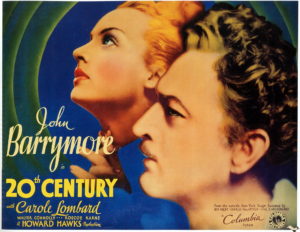 Frank Capra’s It Happened One Night may have kickstarted the screwball genre, but our next entry, Howard Hawks’ Twentieth Century, actually invented it. (Or as near to ‘inventing’ as these things come.) Released a full six months before Night , and also produced by then-struggling Columbia Pictures, Twentieth Century set a whirlwind, blisteringly-paced standard for all future daffy romances that few subsequent pictures dared to match. It’s the Siege of Vicksburg re-imagined as a light romantic comedy. So let’s take another little look-see, shall we?
Frank Capra’s It Happened One Night may have kickstarted the screwball genre, but our next entry, Howard Hawks’ Twentieth Century, actually invented it. (Or as near to ‘inventing’ as these things come.) Released a full six months before Night , and also produced by then-struggling Columbia Pictures, Twentieth Century set a whirlwind, blisteringly-paced standard for all future daffy romances that few subsequent pictures dared to match. It’s the Siege of Vicksburg re-imagined as a light romantic comedy. So let’s take another little look-see, shall we?
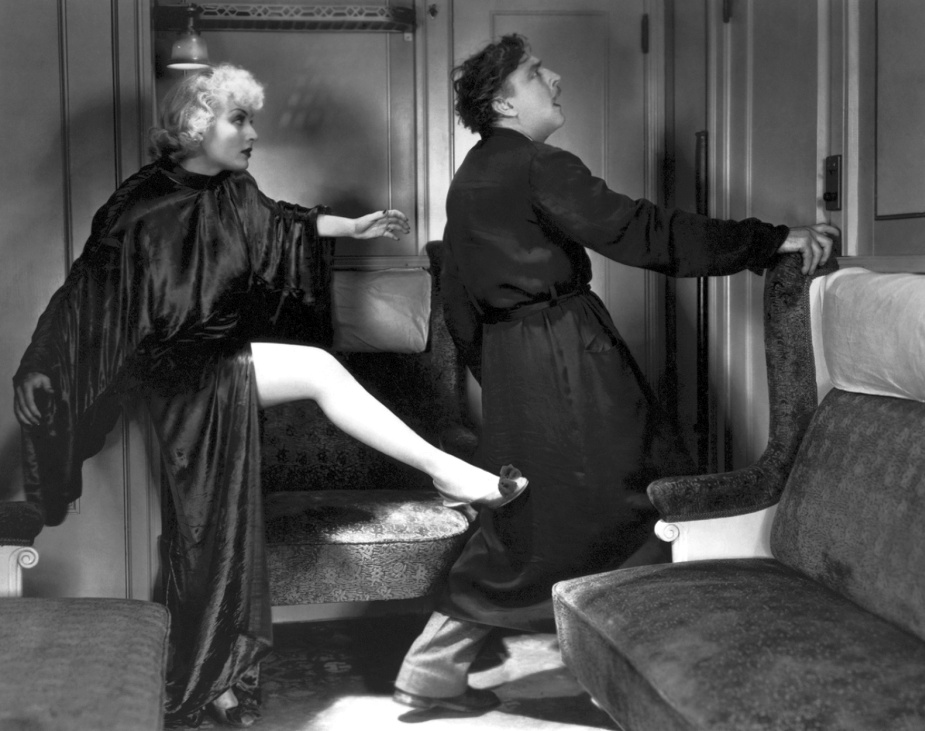
“Oscar, you’re complete. The most horrible excuse for a human being that ever walked on two legs.”
Set mostly on the old Chicago-New York rail run of the old “20th Century Limited,” former lingerie model-turned-theatre diva “Mildred Plotka, aka ‘Lily Garland’” (Carole Lombard), after several years spent “out among the Philistines” in Hollywood, returns triumphantly from her latest screen triumph to reclaim her artistic glory on Broadway. Unbeknownst to her, her former mentor/lover/Svengali, the terrifying theatre impresario “Oscar Jaffe” (John Barrymore), is also aboard and is hellbent on signing his former protégé to appear as Mary Magdalene in a spectacular Passion Play—a production that will salvage his long-since floundering career.
It’s quite literally the Battle of the Century as the then-fastest train on earth hurtles headlong and heedless through a maelstrom of witty invective and unrelenting comic mayhem, a ride that witnesses two giant egos CLASH in sublimely entertaining fashion.
Written by Ben Hecht & Charles MacArthur, two former newspaper writers whose landmark play “The Front Page” had taken Broadway by storm five years earlier, Twentieth Century features the same lightning pacing and rapid-fire dialogue that had so astonished Depression-era audiences but, y’know, “with a little sex.” (To quote a later screwball classic.) And it was that fortuitous combination, I’d argue, that gave birth to an entire genre of (and, not to mention, a new language for) American picture-making. Strap yourself in, folks, ‘cause this is where it all started!
III. MY MAN GODFREY (1936, Universal, dir. Gregory La Cava)
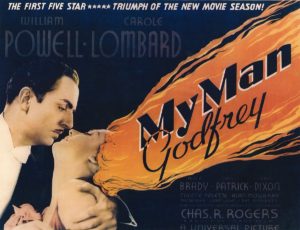 Oh, those merry pranksters and their hilarious hijinks up on Park Avenue!
Oh, those merry pranksters and their hilarious hijinks up on Park Avenue!
What with millions of Americans out of work, what better way to celebrate the Great Depression than a buncha partying rich folks scavenge-hunting about New York City for a “forgotten man”? Wealthy heiress “Irene Bullock” (Carole Lombard) finds one living on the city dump (“Godfrey,” William Powell) who, after ‘rebuffing’ her imperious sister “Cornelia” (Gail Patrick) on a convenient ash pile, agrees to produce himself before a gathering of society’s upper crust in order to be adjudged truly and desperately homeless… but not before letting the well-to-do have it square between the eyes with a finely-articulated bit of proletarian speechifying.
Chastened, bowled-over, and not to mention impressed, the dizzy young socialite offers this unemployed jim dandy from the East River a job: butler to the batty Bullock clan—which, in addition to sisters Irene and Cornelia, includes practicalpaterfamilias “Alexander” (Eugene Pallette), flighty society matron “Angelica” (Alice Brady) and, just for good measure, a vaguely Eastern European artiste who appears to function as the family’s court jester (“Carlo,” Mischa Auer). Godfrey, unwisely, accepts. And so it begins!
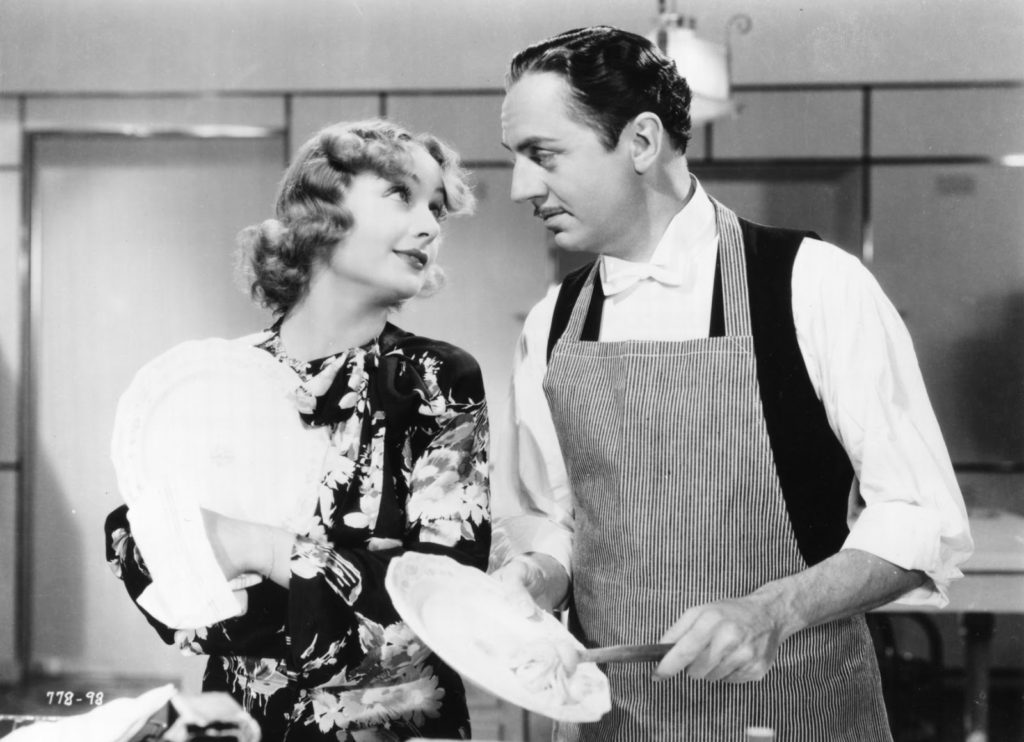
“Stand still, Godfrey. It’ll all be over in a minute.”
Equal bits P.G. Wodehouse and screwball shenanigans, with just a dash of social commentary, Godfrey is a prime example of 30’s Hollywood comedy styling: played-out on magnificent Art Deco sets, in gooey gowns and form-fitting tuxes, under the glossy sheen of overlit photography, and all in a tumult of cockeyed craziness and witty wordplay. It’s entirely possible that when one thinks of ‘screwball’ one can’t help recalling, say, a horse randomly neighing offscreen in the family library—which, of course, is a scene ‘straight’ from this movie.
But what I think REALLY sells this movie is the unbeatable chemistry between down-to-earth Powell and over-the-moon Lombard. One of the key features of the screwball romance, as a genre, is the comic inversion of the woman chasing the man (rather than the man chasing the woman, obviously). In the end, Powell’s Godfrey doesn’t so much ‘fall’ for the brattily persistent tactics of Lombard’s lovelorn Irene—of which, I have on pretty good authority, most closely resemble those of a 4-year old girl (and a particularly ill-mannered one at that)—so much as eventually ‘surrender.’ The film’s final lines—faithfully transcribed over this write-up—pretty much sums up our own resignation to a charming ‘fate worse than’ as it does the title character’s.
IV. BRINGING UP BABY (1938, RKO, dir. Howard Hawks)
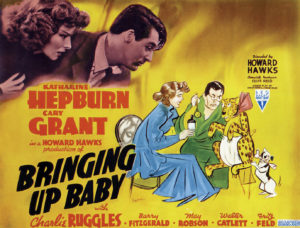 “I’m sitting in the middle of 42nd Street waiting for a bus.”
“I’m sitting in the middle of 42nd Street waiting for a bus.”
That comically frustrated nonsequitur is courtesy of a bespectacled paleontologist (Cary Grant) who in the past 24 hours has entirely compromised both his professional and personal life by slicing his ball off a golf course, witlessly participating in the theft of his own car, tearing the tail-lining of a borrowed tuxedo, standing idly by as the lawyer of his potential millionaire benefactress is struck with a rock, and being pursued down a New York City sidewalk by a music-loving leopard named “Baby.” He’ll later be discovered in a Connecticut country home wearing a negligee, a dog will bury the last remaining jigsaw piece—an ‘intercostal clavicle’—to his giant Brontosaurus skeleton, he’ll run afoul of yet another leopard—this one particularly bad-tempered and evil—and, finally, he’ll be thrown in jail under the alias of “Jerry the Nipper.”
The author of all this wanton confusion? One madcap heiress named “Susan Vance” (Katherine Hepburn).
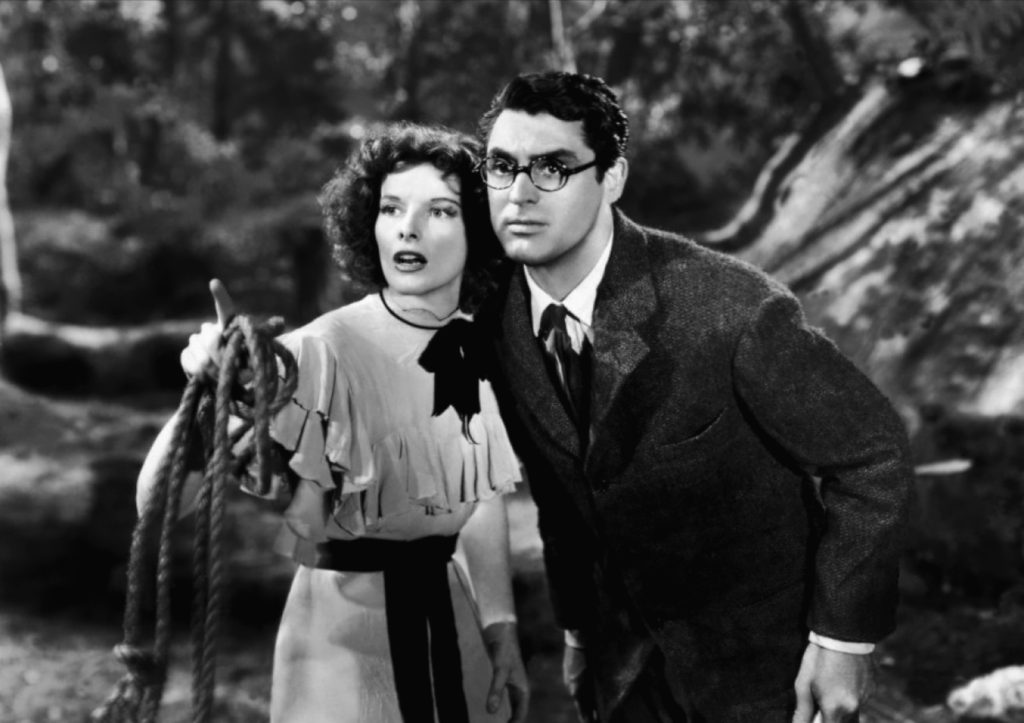
Yes, friends, we are once again in the improbable and irresponsible realm of that magical other-reality called “Screwball.” I think the term probably originated from baseball, where being “thrown a curve” with some added English at the plate makes for a ‘screwy’ trajectory both difficult to gauge and impossible to predict. And that very much describes the sensation of watching this movie!
Dunno if an entire movie can be described as suffering from a psychiatric disorder, but director Howard Hawks, screenwriters Dudley Nichols and Hagar Wilde, and a cast of unusually committed performers—including some great old Hollywood characters like Charlie Ruggles, Walter Catlett, and Fritz Feld—make a comically-insane nightmare out of, basically, 101 uninterrupted minutes of ‘unquiet’ where at no point does any character understand what any other character is saying or doing, or is yet able to provide any sense whatsoever to the proceedings. Basically, the movie doesn’t so much ‘end’ as ‘collapse.’ (Literally!)
It’s wild, witty, and wonderful. A notable failure in its day, it has since been revalued as a true classic of the genre—perhaps THE classic of the genre—but, friend, a slight word of warning: Come Prepared as it’s all quite Out There. (Such comically stressful situations, I can say with some experience, has been known on occasion to lower the body’s natural defenses to encroaching viruses.) I can just imagine audiences in early 1938 shaking their heads in befuddled bewilderment as, say, Katherine Hepburn stands laughing her head off over Cary Grant when he nearly falls to his death down the side of a steep hill… and that she soon comes tumbling down after probably offers about as much in the way of clarifying consolation as the conclusion to “Jack & Jill.”
Intermission: Wacky Wedlock!
Sleek & Sophisticated Later Years: Post-1940
Thus far in our brief incursion into the weird, wild, and wacky land of SCREWBALL we have covered the courtship and honeymoon period of the mid-to-late 1930s and are now prepared—with some trepidation, perhaps—to encroach upon its bust-up and break-down epoch of the early 1940s. Leo McCarey’s 1937 The Awful Truth—besides being the first movie in which actor Cary Grant fully assumed the suave and sophisticated film persona that quickly transformed him into a screen icon—was also one of the first films in the post-1934, post-Production Code era to deal, albeit comically, with the then-taboo topic of divorce.
Though subsequent films like The Philadelphia Story (1940), Mr. Lucky (1940), and Mr. and Mrs. Smith (1941) were quick to uphold the institution of marriage by having their respectively feuding couples reunite in holy matrimony by the final reel, this nonetheless marked a shift in the increasingly direct manner by which filmmakers like Garson Kanin (1939’s Bachelor Mother), Ernst Lubitsch (1943’s Heaven Can Wait), and Preston Sturges (1944’s The Miracle of Morgan’s Creek) were able to deal with, and comically dispose of, subjects as variably-verboten as premarital sex, infidelity, and out-of-wedlock pregnancy.
While in the lightest and deftest manner, of course, a franker depiction of and less reticent attitude towards Topic A was almost inevitable for later Screwball classics that subtly challenged the then-prevailing “standards of decency.” Indeed, the subtext in an oft-quoted line like “Why don’t you slip out of those wet clothes and into a dry martini?”, included by Billy Wilder in his 1942 directorial debut, The Major and The Minor, has arguably rounded the bend towards pure text!
V. HIS GIRL FRIDAY (1940, Columbia, dir. Howard Hawks)
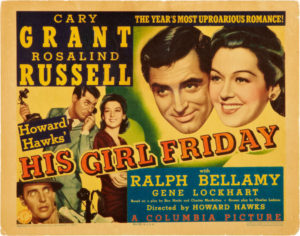 Former Chicago newspapermen Ben Hecht and Charles MacArthur’s play “The Front Page” premiered on Broadway in 1928, thrilling audiences with its rapid-fire dialogue and liberal use of four-letter words. The play ran for about a year and was adapted independently by director-producer Lewis Milestone into a very successful early talking picture, distributed by United Artists, in 1931. Hecht and MacArthur wrote a couple more plays together, and Ben Hecht became Hollywood’s top screenwriter—penning such classics as Scarface (1931), Nothing Sacred (1937), Wuthering Heights (1939), and Notorious(1946). (Hecht’s uncredited rewrite of Gone With The Wind (1939), for one, provided many of its most memorable moments. Mainly of scenes set in bedrooms and brothels.) I think it’s no exaggeration to say that the success and influence of “The Front Page” set a standard for Hollywood talking pictures. The rhythms and attitude of its language gave the Hollywood Talkie its energy and ‘snap.’
Former Chicago newspapermen Ben Hecht and Charles MacArthur’s play “The Front Page” premiered on Broadway in 1928, thrilling audiences with its rapid-fire dialogue and liberal use of four-letter words. The play ran for about a year and was adapted independently by director-producer Lewis Milestone into a very successful early talking picture, distributed by United Artists, in 1931. Hecht and MacArthur wrote a couple more plays together, and Ben Hecht became Hollywood’s top screenwriter—penning such classics as Scarface (1931), Nothing Sacred (1937), Wuthering Heights (1939), and Notorious(1946). (Hecht’s uncredited rewrite of Gone With The Wind (1939), for one, provided many of its most memorable moments. Mainly of scenes set in bedrooms and brothels.) I think it’s no exaggeration to say that the success and influence of “The Front Page” set a standard for Hollywood talking pictures. The rhythms and attitude of its language gave the Hollywood Talkie its energy and ‘snap.’
So when director Howard Hawks came to Columbia with his proposal for a remake it wasn’t all that hard a sell. A bit harder sell, though, was his sudden decision mid-casting to change the role of the reporter character from a man to a woman. Well, why not? “The Front Page” became His Girl Friday.
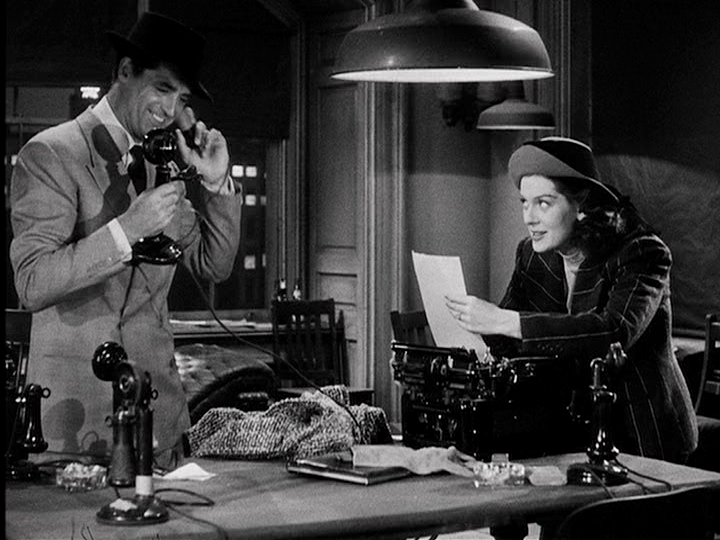
“Take Hitler and stick him on the funny pages!”
In an unnamed city, probably Chicago, star reporter “Hildy Johnson” (Rosalind Russell) is about to leave the exciting world of cutthroat journalism—and, not to mention, her editor and former husband(!) “Walter Burns” (Cary Grant)—for the umbrella-carrying, slickers-wearing bore “Bruce Baldwin” (life-and-the-movie’s eternal also-ran, Ralph Bellamy) and a comfortable life of leisure and life-insurance policies in Albany, New York. But ol’ Walter ain’t gonna let Hildy off that easy. Before she knows where she’s at, or we know where any of them are going, Walter bullies, bluffs, blusters, bulldozes, and bamboozles Hildy into chasing the biggest story of the year. And by the end, justice served, order restored, and a good story gotten—in just about the most cockeyed fashion immorally and irresponsibly conceivable—Hildy is back with Walter, Bruce is on the outs, and she’s a “newspaperman” once more!
This is just about the briskest 93 minutes you’ll ever take. Characters are talking so fast, and at the same time, that I’d advise viewers of today to turn on the English subtitles—even if you have whatever the hearing equivalent of ‘20/20 vision’ is. It’s so lightning quick, I think, that you won’t even be bothered by the troubling aspects of the reporter/editor and ex-husband/wife relationship at the center of it. Sure, Walter ‘gives’ it to Hildy quite good, but personally, I think the old girl can take it—and dishes out her fair share in return. As an almost accidental ‘screwball,’ His Girl Friday is one of the fastest, fiercest, furious-est AND funniest!
VI. BALL OF FIRE (1941, Samuel Goldwyn Prod., dir. Howard Hawks)
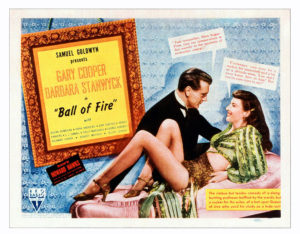 Eight professors who, together, possess the sum total of all human knowledge reside in a gingerbread-style brownstone near Central Park in Manhattan, compiling a mammoth encyclopedia. They’ve just broken through to ‘S,’ which contains a subject “about which they know very little…”
Eight professors who, together, possess the sum total of all human knowledge reside in a gingerbread-style brownstone near Central Park in Manhattan, compiling a mammoth encyclopedia. They’ve just broken through to ‘S,’ which contains a subject “about which they know very little…”
Well, two subjects, actually, as Harvard English professor and ‘grammarian’ “Bertram Potts” (Gary Cooper!) discovers when a lexicographically frustrating conversation with the local garbageman (Allen Jenkins) shows that his article on “Slang” is at least twenty years out of date. “’Smooch’? “Dish”? “Hoytoytoy”?!! “That man talked a living language! I embalmed a few dead phrases.” So, like any responsible scientific practitioner, the good professor takes to the streets for some practical “research.”
In the course of his “studies,” Potts takes in a nightclub performance by Gene Krupa & His Orchestra (Themselves) featuring one “Sugarpuss O’Shea” (Barbara Stanwyck), whose verbal and linguistic acumen regarding the early 1940’s American demotic is, in his estimation, “nonpareil.” Initially rebuffing his purely professorial advances, Sugarpuss has cause to rethink Potts’ invitation for “collaboration” when the police pick up her gangster boyfriend (Dana Andrews) on a murder charge, and she needs a place to hide-out, instanter…
And so, Professors “Oddly, Magenbruch, Jerome, Gurkakoff, Quintana, Robinson & Peagram” (Richard Haydn, S.Z. Sakall, Henry Travers, Oscar Homolka, Leonid Kinskey, Tully Marshall & Aubrey Mather—perhaps the most memorable assemblage of Classic Hollywood character actors, EVER) are soon the ever-so-wise-but-oh-so-unworldly Seven Dwarfs to a most unlikely Snow White—with Professor Potts an even more unlikely Prince Charming! (Or is he the one from “Cinderella”? Oh, well.)
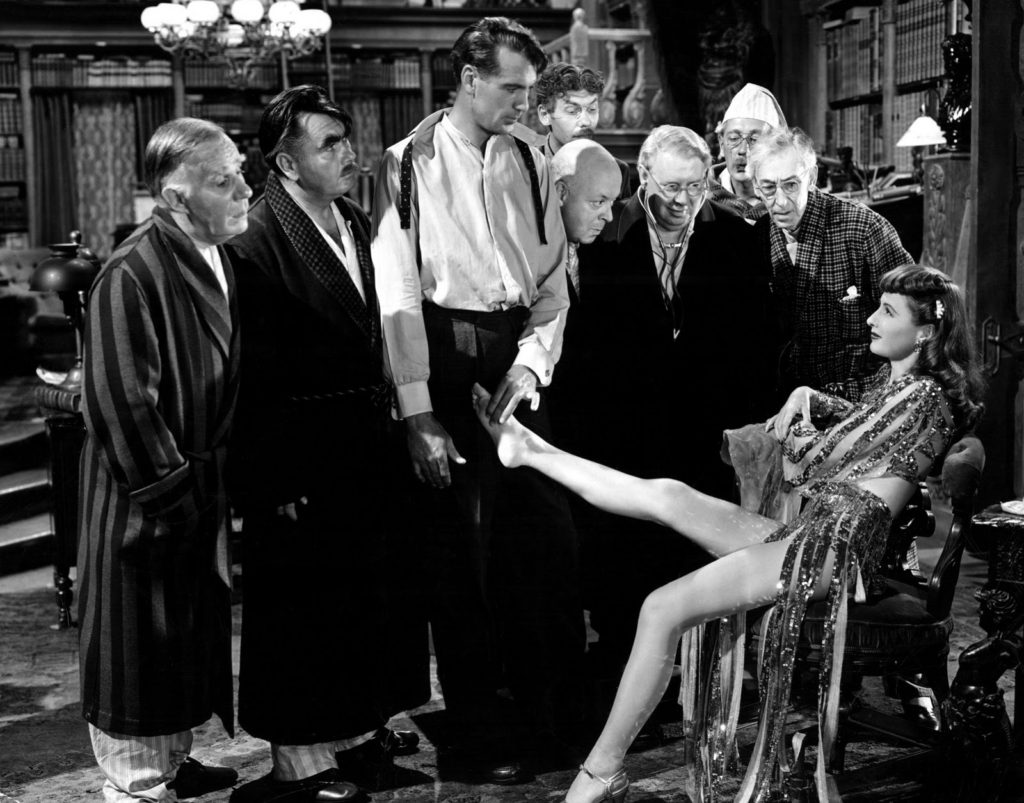
“That is the kind of woman that makes whole civilizations topple.”
In the past few entries I’ve fairly blazed through the filmography of director Howard Hawks. And I guess it’s kinda unavoidable when it comes to this genre and this style of filmmaking. The late critic Andrew Sarris famously described the Screwball Comedy as “sex comedies without the sex”—which makes a lot of sense considering that any direct reference to Topic A was strictly VERBOTEN after the 1933 drafting of Hollywood’s puritanical Production Code. Hawks’ fireball pacing, dizzying dialogue and, particularly, a cockeyed attitude toward “romance” was a ‘natch for comically explicating an epic, though essentially sexless, War Between The Sexes.
Ball of Fire, though, is something slightly different. Written by Billy Wilder and Charles Brackett, who had been pushing the envelope rather hard at Paramount with risibly ribald and risqué scripts for movies like Bluebeard’s Eighth Wife (1938) and Midnight (1939), the fairy-tale setting of the Classic Hollywood romantic comedy is literally stormed down as the professors’ cozy little bachelor paradise is intruded upon, and their innocence compromised, by the very subject these Eight Dwarfs can’t seem to get past—bogged down as they are, of course, in the “S”-s.
All I can say is it’ll probably be a “most illuminating” encyclopedia entry once Sugarpuss O’Shea is through with ‘em.
VII. THE PALM BEACH STORY (1942, Paramount, dir. Preston Sturges)
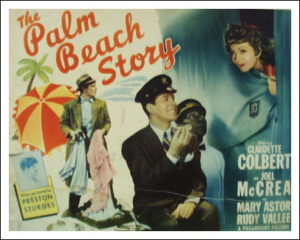 Following a totally incomprehensible silent movie-style prologue (beginning with a fainting maid, an apparently Houdini-like escape from being bound, gagged and locked in a closet, and ending with a frantic race to the altar—all of which, by the way, is only made clear in the last few moments of the film), we catch up with Tom and Gerry Jeffers (Joel McCrea and Claudette Colbert) five years after their whirlwind marriage to find them on the skids, financially, and in danger of losing their swank, upper East Side Manhattan apartment.
Following a totally incomprehensible silent movie-style prologue (beginning with a fainting maid, an apparently Houdini-like escape from being bound, gagged and locked in a closet, and ending with a frantic race to the altar—all of which, by the way, is only made clear in the last few moments of the film), we catch up with Tom and Gerry Jeffers (Joel McCrea and Claudette Colbert) five years after their whirlwind marriage to find them on the skids, financially, and in danger of losing their swank, upper East Side Manhattan apartment.
Unfortunately, Tom can’t seem to raise the necessary $99,000 to build his “sure-fire, can’t miss” idea for a ‘cable wire-suspended airfield’ (“Works on the principle of a strung tennis racket”), and the resulting lack of revenue is putting a strain on their marriage. So Gerry, after a fortuitous meeting with a prospective renter called the “Wienie King” (Robert Dudley), who turns out to be her fairy godmother in the form of eccentrically-bequeathed cash, decides to up and leave Tom and use the Wienie King’s money for a quickie divorce in Palm Beach, Florida…
Confused? Well, you ain’t heard nothin’ yet.
After an early morning escape to the train station, Gerry boards a train for Palm Beach where she encounters a group of drunken millionaires known as the “Ale & Quail Club” (The Unofficial Preston Sturges Stock Company), who sponsors the, um, ‘hapless waif’ as their “mascot.” Unfortunately, the “Ale” part of their name is more than in evidence as the journey progresses and, after one (or 10) too many, the Ale & Quail-ers begin taking live shell-loaded target practice in the open dining car. Gerry flees in terror, and while the Hunting Club forms a posse—dogs, rifles, and all—to find her, the conductor deems it prudent to simply detach the last cars of the train, stranding the hootin’, hollerin’, and rifle-shootin’ millionaire miscreants somewhere out in Tennessee…
Meanwhile, Tom is back in New York and *also* receives a visit from his fairy godmother in the shape of the eccentric Wienie King. Cash in hand, he boards a flight to Palm Beach.
Meanwhile-Meanwhile, Gerry has ‘met-cute’ with yet another eccentric millionaire—nay, billionaire—named “John D. Hackensacker III” (Rudy Vallee), the “Oil Baron.” The pair disembark at Jacksonville, where John D. treats ‘hapless’ Gerry to approximately 10 trunk-fulls of ‘lost luggage,’ before they both board his 300-ft. yacht for Palm Beach.
Spotting Tom waiting at the dock in Palm Beach, Gerry deems it prudent herself to present Tom to the now-smitten John D. as her brother, “Captain McGlue”—before all are joined by John D.’s thrice-married, (and twice-annulled) man-crazy sister, “The Princess Centimilia” (aka “Maude,” Mary Astor). And, just for good measure, tagging-along in dog-like, servile devotion is the Princess’s latest conquest/hanger-on—a ‘Balluchistanian’ refugee known only, appropriately, as “Toto” (Sig Arno)…
And then, well, things just get really crazy.
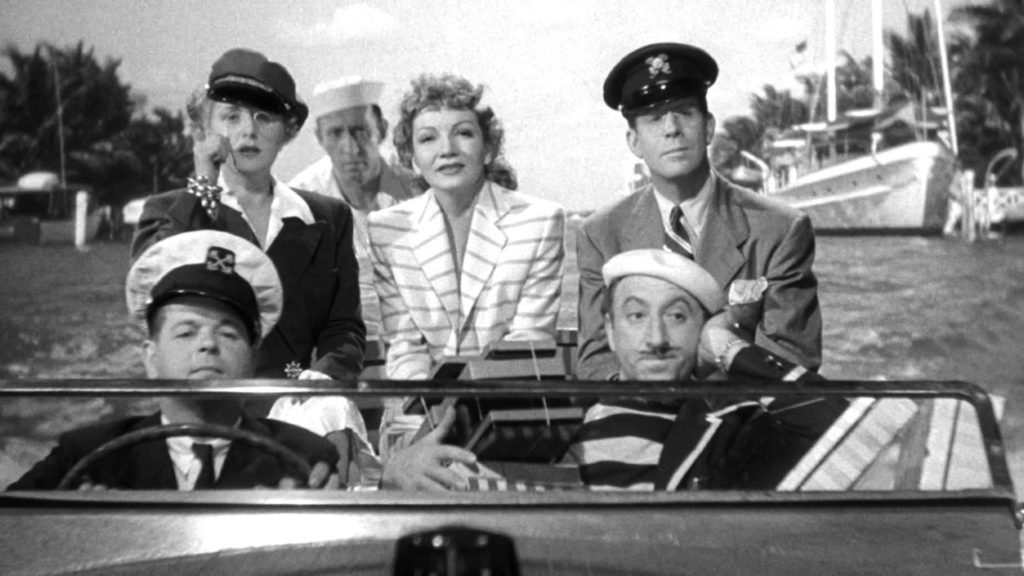
“‘After I’m married…’ That’s certainly a funny thing to hear your wife say.”
The mad genius of Preston Sturges is nowhere more in evidence than in these 87 minutes of comically-sustained insanity. (Really, even the most detailed plot description can’t do justice to such masterful comic inventions as The Wienie King, The Ale & Quail Club, “Captain McGlue,” or “Toto.”) Sturges’s Golden Years at Paramount (1940-44) were undoubtedly a great gift to the world of comedy during The War, and his romantic comedies in particular (this one, and The Lady Eve from 1941) brought the Screwball to the level of fine art.
And as for Sturges’s trademarked WALLOPS, nothing can beat the final 30 seconds or so of this movie, in which every strand of mounting madness unravels to reveal possibly the funniest final shot in film history.
Yep, it’s a doozy.
VIII. TO BE OR NOT TO BE (1942, United Artists, dir. Ernst Lubitsch)
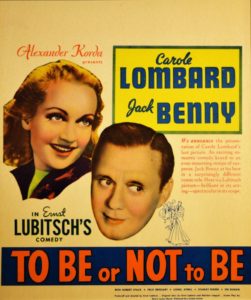 Poland, 1939. A theater company headed by that “great, great Polish actor, Joseph Tura” (Jack Benny) and his wife, “Maria” (Carole Lombard), is attempting to pull off a satire about Hitler and the Nazis when government officials shut the production down in favor of something a little less political. So, shortly before the evening’s substitute performance of “Hamlet”—featuring Tura’s famous/infamous performance of the ‘melancholy Dane’—Maria receives a bouquet of a flowers from a young Polish flyer named “Lt. Sobinski” (Robert Stack). Flattered, and knowing her vain husband will hammily stretch the famous three minute and a half soliloquy to at least ten, suggests the handsome pilot repair to her dressing room when Tura begins the “To be or not to be…” speech.
Poland, 1939. A theater company headed by that “great, great Polish actor, Joseph Tura” (Jack Benny) and his wife, “Maria” (Carole Lombard), is attempting to pull off a satire about Hitler and the Nazis when government officials shut the production down in favor of something a little less political. So, shortly before the evening’s substitute performance of “Hamlet”—featuring Tura’s famous/infamous performance of the ‘melancholy Dane’—Maria receives a bouquet of a flowers from a young Polish flyer named “Lt. Sobinski” (Robert Stack). Flattered, and knowing her vain husband will hammily stretch the famous three minute and a half soliloquy to at least ten, suggests the handsome pilot repair to her dressing room when Tura begins the “To be or not to be…” speech.
As those fateful words are intoned during that night’s performance, Sobinski purposefully and noticeably exits for an assignation with the wife of the man who is then essaying Hamlet on-stage! Tura, thinking he has been walked out on during his moment of great acting triumph, is mortally offended, lending an unusual amount of verisimilitude to his pronouncement of the phrase “outrageous fortune.” But that outrage is short-lived when Tura & Co. learns soon after that night’s performance that German tanks have crossed the Polish borders…
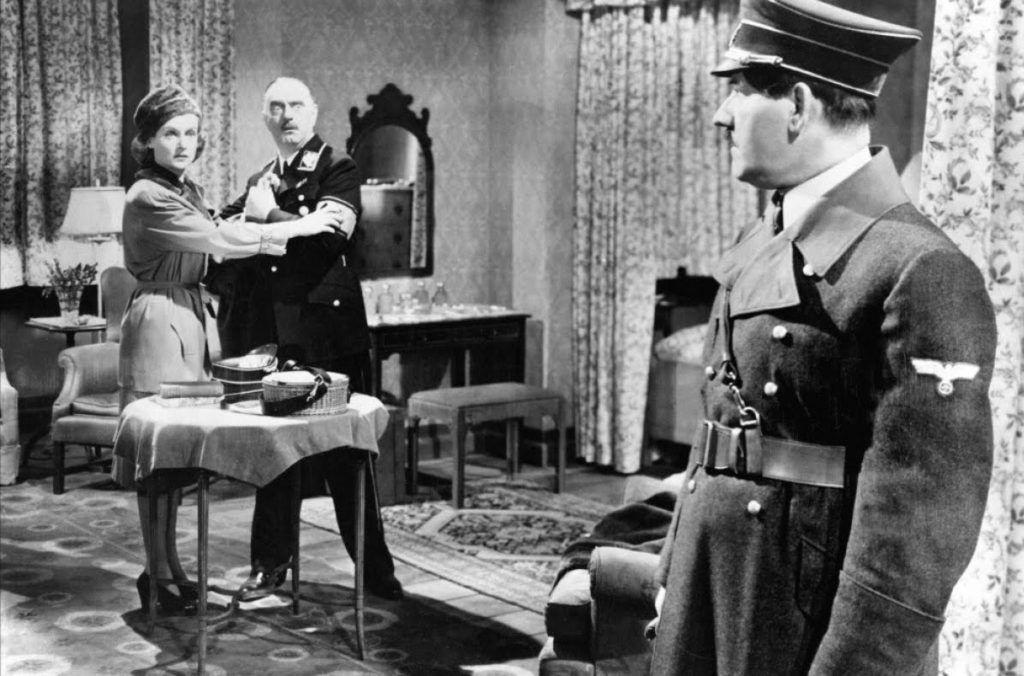
“They named a brandy after Napoleon, they made a herring out of Bismarck, and the Fuhrer is going to end up as a piece of cheese!”
And so begins the very last entry on my series of Screwball Comedies. Hardly a promising premise for a farcical comic romance, I agree—Infidelity! Deception! Invasion! Nazis!—but the great Ernst Lubitsch, along with a wonderful troupe of actors (playing, of course, a wonderful troupe of actors), pulls off difficult subject matter with style and aplomb.
Yeah, it’s one thing to demonize your enemy, casting them as the villains in your propaganda piece, and it’s quite another to make them appear ridiculous. The Nazis, representing the greatest evil of our times, WERE ridiculous—I mean, try watching a minute of Leni Riefenstahl’s 1935 Nazi-extolling documentary Triumph des Willens without breaking into peals of horrified laughter—and it took the comic genius of German-Jewish émigré Lubitsch to expose the Nazis for what they were: a pack of murderous clowns.
Yes, folks, the true power of comedy!

